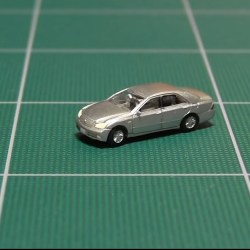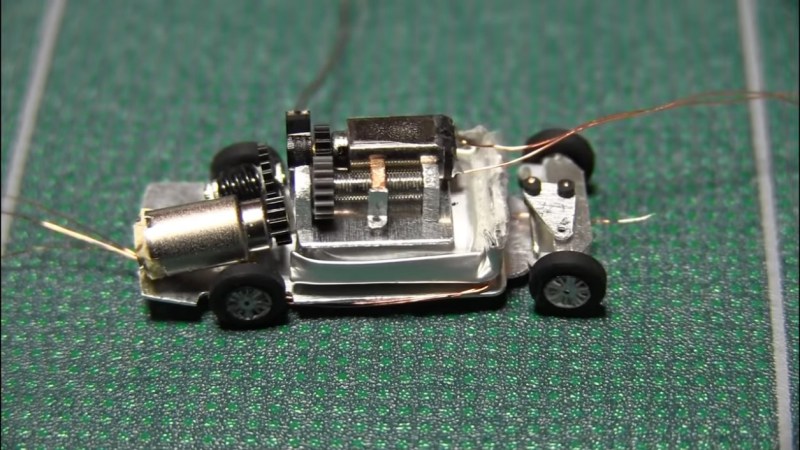Tiny remote control cars burst onto the scene from time to time, often sold from mall kiosks and covered in garish stickers. However, sometimes it’s more fun to build than to buy. [diorama111] clearly fits into this camp, building a tiny 1:150 scale RC car from the ground up.
 The build starts with a Tomy 1:150 model Toyota Crown / Avalon. However, only the outer shell remain. From giving the wheels rubber tires and fabricating a delicate steering assembly, to adding motors for both locomotion and turning, the mechanical build is on point. But seeing the ATtiny1616 is deadbugged with a DRV8835 motor driver, with the SMD parts hooked up with magnet wire to save the most space possible is equally impressive. A PIC79603 IR module is used to receive the commands to drive the car.
The build starts with a Tomy 1:150 model Toyota Crown / Avalon. However, only the outer shell remain. From giving the wheels rubber tires and fabricating a delicate steering assembly, to adding motors for both locomotion and turning, the mechanical build is on point. But seeing the ATtiny1616 is deadbugged with a DRV8835 motor driver, with the SMD parts hooked up with magnet wire to save the most space possible is equally impressive. A PIC79603 IR module is used to receive the commands to drive the car.
The build is an artful one, and all done by hand — no 3D printing or CNC parts involved. Watching the car drive is a delight. The smooth analog steering and slow speed give it an excellent scale appearance. The only thing we wonder about is the difficulty of driving it quickly without the aid of self-centering steering. It reminds us fondly of the 1:96 scale fully-functional Mustang RC plane we featured in 2017. Video after the break.
[Thanks to killergeek for the tip!]
















now even children can experience the thrill of driving a 1999 Toyota Camry! all jokes aside this is nice to see such great freeform circuitry work
The caption in the first few seconds says TOMYTEC 1/150 TOYOTA CROWN, so not a Mercedes, despite appearances.
https://en.wikipedia.org/wiki/Toyota_Crown
The caption in the first few seconds says Toyota Crown, so not quite a Mercedes.
Thanks. Fixed.
Toyota crown – looks like a merc
If only my hands didn’t shake so much and my eyes worked properly…
It’s amazing to see such fine detail work done.
You could use a microscope like for soldering?
There’s some interesting work being done in managing essential tremor and parkinson’s using active stabilization, where people have motors with off-center weights strapped to the backs of their hands, with the motors running at the right speed to cancel the tremor. (Harder with essential tremor as it’s variable and focal as the hand approaches the object, but still possible.) The cheap version of this, that a friend has used, is using an ace bandage to bind a can of tuna to the back of each hand. The extra weight damps the tremor significantly.
Interesting, Thanks!
I vaguely remember people mentioning remote control Micro Machines back in the day. And this is how I imagined them.
The metal button on the bottom of Micro Machines cars was so you could put them on a piece of cardboard and drive them around with a magnet.
super impressive. The steering alone had me floored.
“…what looks to be a Mercedes.”
It’s a Toyota Crown. I think it’s the Avalon in the US.
Anyway, I like the steering mechanism. The screw drive makes the turning motion much smoother and more realistic compared to a servo. Well done.
Technically, it’s a linear servo, of which you can find manufactured versions as well. The main difference is the use of the rotary encoder vs. a linear pot to detect the position.
Dare you to upgrade to a differential drive! It looks like old school stop animation because of the small scale. A Mac keyboard would be like paving stones compared to getting stuck between the letters. The IBM style keys look like tank traps.
OH MY GOD!!! This is the best hackaday poster EVER!!!
Nicely done and quite clever.
TOMYTEC
CHINA 2010
doesn’t look handmade to me
this modification could be considered as a work of art!
Nicely done!
Amazing work.
Needs a tiny wifi camera, so that it could steer automatically with a remote computer.
Or maybe even use some IR sensors/photoresistors, and make a line follower that is driven by the µC he has already installed. Could make the car follow lanes automatically.
Very impressive !!
Recently I saw a youtuber putting together a very small (I think he mentioned it would go with HO gauge trains) radio controlled vehicle from a kit. I initially thought that might be a fun thing to do, but the number of teeny tiny corrections and modifications he had to make to get it to go together, and get it to work, really dissuaded me. It was beautiful work, but I think the word ‘kit’ was misapplied. I remember one of the steps was to file down the two pieces of (essentially) wire that form the rear axle to semicircles so that where they overlapped they could actually sit together to form a circular profile that would fit inside a tiny gearbox.
Really cool work, I especially liked the mini-lathe and using a file as a cutter. Goes to show that we don’t need CNC and 3d printers everywhere.
I would have probably not have used the complicated steering mechanism; there are some micro linear servos, probably used for focus control, 10 for 1$.
Are there any micros with embedded motor drivers?
Too bad the remote control firmware is proprietary…
I guess he meant he made it himself…the source code is there.
This reminds me the tiny BT RC car sold by Sony Ericsson. I was a kid back then and I wanted one so bad… But it was too expensive for me. I bought a cheaper simple radio version later. So much fun.
The annoying thing was the control. Steering was just an electromagnet left/right/centered by spring. 2 speeds: forward full throttle, reverse full throttle.
I wish I had time for something like this nowadays. Everyday tech is more advanced now, easily possible.